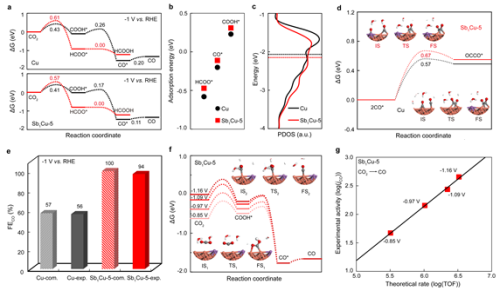
Renewable electricity-powered CO evolution from CO2 emissions is a promising first step in the sustainable production of commodity chemicals, but performing electrochemical CO2 reduction economically at scale is challenging since only noble metals, for example, gold and silver, have shown high performance for CO2-to-CO. Cu is a potential catalyst to achieve CO2 reduction to CO at the industrial scale, but the C-C coupling process on Cu significantly depletes CO* intermediates, thus limiting the CO evolution rate and producing many hydrocarbon and oxygenate mixtures. Herein, we tune the CO selectivity of Cu by alloying a second metal Sb into Cu, and report an antimony-copper single-atom alloy catalyst (Sb1Cu) of isolated Sb-Cu interfaces that catalyzes the efficient conversion of CO2-to-CO with a Faradaic efficiency over 95%. The partial current density reaches 452 mA cm−2 with approximately 91% CO Faradaic efficiency, and negligible C2+ products are observed. In situ spectroscopic measurements and theoretical simulations reason that the atomic Sb-Cu interface in Cu promotes CO2 adsorption/activation and weakens the binding strength of CO*, which ends up with enhanced CO selectivity and production rates.